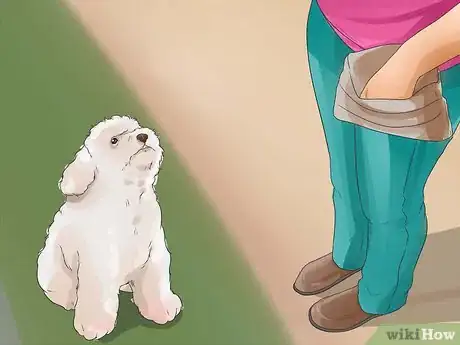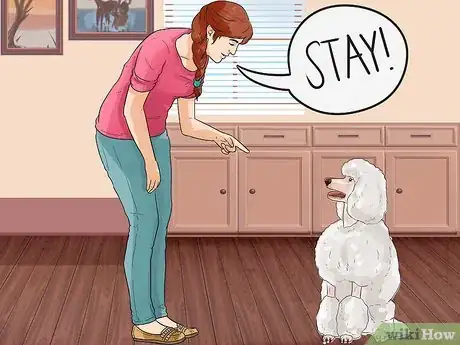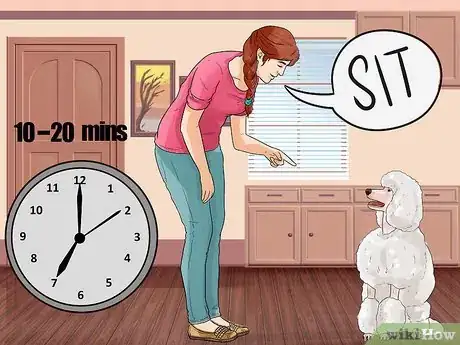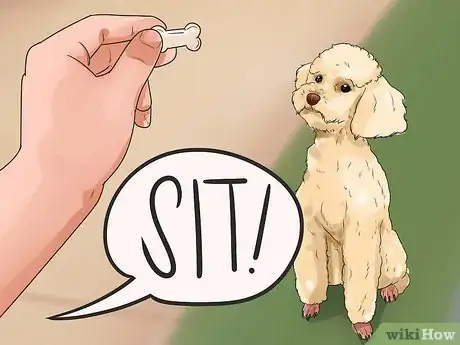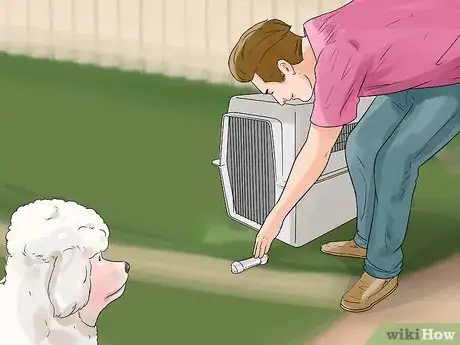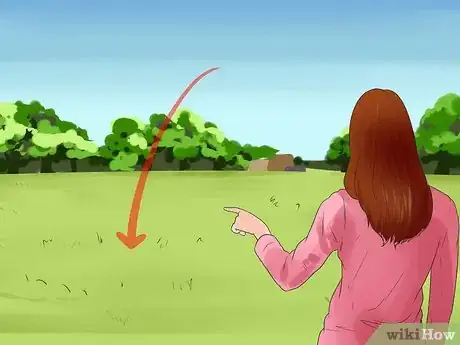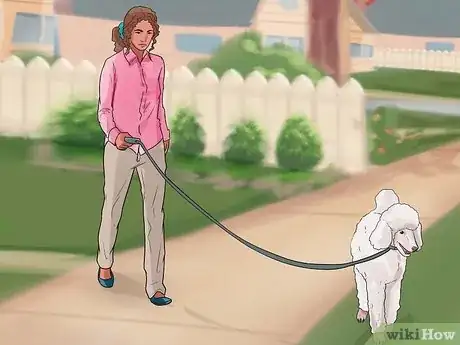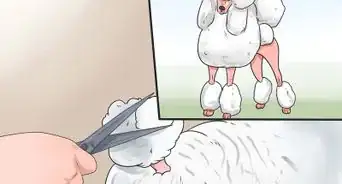This article was co-authored by Pippa Elliott, MRCVS. Dr. Elliott, BVMS, MRCVS is a veterinarian with over 30 years of experience in veterinary surgery and companion animal practice. She graduated from the University of Glasgow in 1987 with a degree in veterinary medicine and surgery. She has worked at the same animal clinic in her hometown for over 20 years.
wikiHow marks an article as reader-approved once it receives enough positive feedback. In this case, 86% of readers who voted found the article helpful, earning it our reader-approved status.
This article has been viewed 132,252 times.
The toy poodle is a playful, loving, and sensitive breed that wants to please its owner. Toy poodles are actually quite intelligent and easy to train with proper techniques. In addition, they are bright and agile, which explains why toy poodles were popular as circus performs in previous centuries. Learning how to train a toy poodle can be both rewarding and easy to accomplish when you know how to go about it.[1]
Steps
Practicing Reward-Based Dog Training
-
1Learn about reward-based training. This is a training method whereby good behavior is rewarded and so the dog wishes to repeat it to get a treat. Bad behavior, on the other hand, is either ignored or acknowledged with a brief verbal rebuke or other (non-violent) means of showing your displeasure. The idea behind this is to provide your dog with information that it chose the wrong action.
-
2Find a training treat that your dog responds to. This might be food, a special toy, or just praising it. Even fussy eaters have something they love to eat that is a special treat for them. The trick is to find this treat. Try morsels of different foods, such as cheese, hotdog sausage, steak, chicken, or a commercial training treat, until you find one the dog really loves. You are going to use this treat as your pup's reward.[2]Advertisement
-
3Keep a small amount of this treat in a treat pouch which you wear on your person. This way you will be ready to reward the dog's good behavior throughout the day. Be careful not to overfeed the dog however. When using treats, cut back on your pup's daily food ration at mealtimes so as to compensate for the extra calories represented by the treats.
-
4Cut back on the treats as your dog learns your commands. Another factor to be aware of is that giving treats every time the dog does good can make it lazy, as the dog assumes it will get a treat. Once it learns to work for treats, make the reward intermittent, such as every fourth or fifth rewardable action, so that the dog stays on his or her best behavior to earn that reward.
-
5Socialize your dog. Training your dog to be a good canine citizen means helping it to be confident in different places, and with different people and other animals. This will help make your pet well-adjusted and able to adapt to various situations without displaying anxiety.
-
6Start toy poodle training, including socialization, when your dog is still young. Puppies have a socialization period where they learn more rapidly, so take advantage of this by taking your puppy to visit other people and carry the puppy alongside roads so she can get used to the sound of traffic and the such like. This window of opportunity closes at 18 weeks, after which the dog continues to learn but more slowly.[3]
- Though adult toy poodles are trainable, it is much easier to teach younger dogs before bad behavior issues arise.
Training a Toy Poodle to Follow Your Commands
-
1Give commands using one-word phrases such as sit, stay, down and quiet. Using long phrases during training can confuse your dog companion and cause delays in the training process. Keep all commands or cue words consistent, which means making sure all family members use the same commands.
-
2Aim for two 10 - 20 minute training sessions a day, plus incorporate training into normal activities. For example, at meal times get the poodle to "Sit" before putting her food down. If the dog is tired or her concentration is poor, then end the session and try again next time - you are more likely to teach her bad habits if you persist when she's not in the mood.[4]
-
3Teach your dog to sit. Position the dog in front of you, so you are looking at each other. Put a treat in your hand and then put your hand in front of the dog, slightly above its head. Most dogs will naturally sit to get a better view of the treat being held above their head.
- Once the dog sits, immediately praise it and give it the treat.
-
4Teach other basic commands. Important commands to teach are stay and recall (getting the dog to come back on demand). When the dog obeys these commands this gives you a great deal of control over her behavior. For example, if she rushes to greet guests, by commanding her to "Sit" you can stop her jumping up at an anxious child.
-
5Start by training your dog in a quiet place with few distractions such as the back yard. As she learns, make sure to expand the places you take her to for training, so she learns to obey under all circumstances, rather than just in the yard.
-
6Consider enrolling at a training class. It is a great way to get your dog used to obeying when there are other dogs around. In addition, the dog trainer can help you use the correct techniques and spot if you are inadvertently not acting correctly.
Potty Training a Toy Poodle
-
1Focus on reducing inappropriate toileting.[5] The principles of potty training are to reward a dog when it toilets in the right place, and to reduce the chances of it toileting in the wrong place. You do this by watching the dog like a hawk indoors, and when it starts sniffing as if to toilet take it outside to the toilet spot.
- Never let the dog have unsupervised access to rooms until it is fully trained. It helps to keep a long line leash on the dog in the house, with the end looped over your wrist. That way you are aware of its movements and can keep a watch.
-
2Keep your toy poodle in a crate when you can't keep an eye on it. You will need to train the dog to use a crate. The principle behind a crate is to act as a den, or a safe place where the dog enjoys spending time. It is large enough for it to stand up or lie down with its legs stretched out, but no more. This then reduces the chances of the dog soiling its den and teaches it bladder control.
- Teach the toy poodle to go into the crate willingly by feeding it in there. Scatter treats or toys in the crate so that the dog associates it as a place where nice things happen. Over time your dog will go in willingly, and you can shut the door.
- Avoid using the crate as a form of punishment.
- Place the crate in an area where your toy poodle can see what is going on in the household so it can get accustomed to the daily routine and not feel lonely. Allow your toy poodle to come out of the crate for longer periods of time each day.
-
3Designate a toileting area and show the poodle where it is.[6] Go with it to visit the toilet spot so that you are there to reward the pup when it squats. Only by rewarding it will it start to build an association with the toilet spot and what the dog is there to do.
-
4Take the dog out on a regular basis. For an adult dog, try to put it on the toilet spot hourly, and especially first thing in the morning and last thing at night. For a puppy, pop it out every 20 - 30 minutes.
- Also be aware that food in the stomach stimulates the need to toilet so offering the toilet spot 15 - 20 minutes after eating will increase the success rate.
Warnings
- Do not use physical force when training toy poodles. Not only are they emotionally sensitive, but they are also physically delicate.⧼thumbs_response⧽
- When training toy poodles, don't leave them crated without regular breaks or in areas where activities and people can't be seen. This would result in isolated, anxious dogs because the breed is very social and loves to be around humans.⧼thumbs_response⧽
- Refrain from yelling or using harsh tones when learning how to train a toy poodle. Because of the sensitivity of the breed, this approach will result in you toy poodle becoming fearful of you.⧼thumbs_response⧽
References
- ↑ http://www.dog-obedience-training-review.com/poodle-training.html
- ↑ The Happy Puppy Handbook. Pippa Mattinson. Ebury Press
- ↑ Canine Behavior: A Guide for Veterinarians. Bonnie Beaver. Saunders
- ↑ The Happy Puppy Handbook. Pippa Mattinson. Ebury Press
- ↑ http://pets.thenest.com/house-train-poodles-6350.html
- ↑ http://pets.thenest.com/house-train-poodles-6350.html
- http://www.dog-obedience-training-review.com/poodle-training.html
About This Article
To train a toy poodle, start by teaching your dog basic verbal commands like "Sit" and "Stay." Give your dog tasty treats and praise during training sessions to positively reinforce the new behaviors and limit training to two 10-20 minute sessions per day. To potty train your poodle, designate a specific spot outside and bring your dog to that area every time it needs to go. Try to bring your dog out once per hour to relieve itself and don't forget to reward it with a treat after each successful trip! For tips on socializing your toy poodle, read on!


